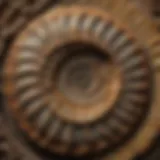Understanding Real Moldavite: Identify Genuine Tektites
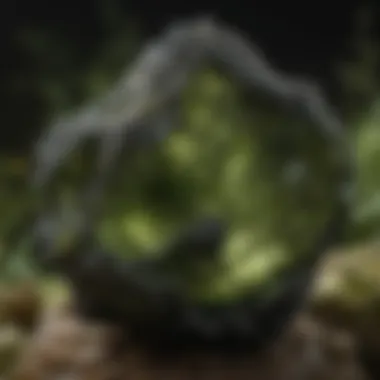

Intro
Moldavite, a rare and captivating tektite, holds a place of fascination among collectors and enthusiasts. Originating from the impact of a meteorite roughly 15 million years ago in what is now the Czech Republic, genuine moldavite boasts unique traits associated with its cosmic origins. In this guide, we will explore not only the characteristics of authentic moldavite but also its fascinating history and the prevalent myths surrounding it. For those who crave deeper knowledge, understanding real moldavite is crucial.
Rock and Fossil Identification
Types of Tektites
Moldavite is categorized as a tektite. Other types of tektites include Libyan Desert Glass and Philippine Tecktites. Each differing in composition and origin. Moldavite itself exists in shades of green, often with a textured surface. Its unique earthly hues differentiate it from indistinguishable igneous rocks.
Characteristics to Look For
When identifying real moldavite, there are key characteristics to consider:
- Color: Genuine moldavite primarily appears in shades of green, varying from olive to deep forest green.
- Texture: It often features a distinct texture. Surface signs like "wrinkles" or "ripples" indicates authenticity, known as "trails."
- Weight: Moldavite is lighter than many rocks due to its glassy structure.
Genuine moldavite often feels warm when held in your hand. Its unique composition affects thermal properties compared to regular stones.
Tools for Identification
Using a few tools can greatly enhance your ability to identify moldavite:
- Magnifying Glass: To inspect the surface inscriptions.
- Scale: Weigh your specimen to confirm its lighter than ordinary rocks.
- Gem Tester: This can help ascertain the refractive index, confirming it is a glass, not a stone.
Collecting Tips and Techniques
Best Practices for Collecting
When collecting moldavite, approach each specimen thoughtfully:
- Research the site of collection. Frequently, reputable chunks are found in the Czech Republic's Moldau Valley.
- Ensure you have permission to collect to avoid legal issues.
Locating Prime Collecting Sites
In addition to the Czech Republic, reports sometimes arise from locations like:
- Germany, but find owners' permissions when seeking.
- Myths about locations would lead you astray. Seek credible sources as reference.
How to Safely Extract Specimens
While dismissing hazardous techniques is crucial, safe extraction from sites is essential. Utilise:
- Hand tools like pickaxes instead of shovels to avoid damage.
- Avoid large machinery.
Preservation and Display
Techniques for Preserving Moldavite
To maintain the integrity of your moldavite, situate it in a climate-controlled environments. Keep it away from direct sunlight to avoid fading.
Proper Storage Methods
Store moldavite specimens in protective containers, such as:
- Soft pouches to prevent scratches,
- Jewelry boxes for those in settings, as proper compartments minimize movement.
Creative Display Ideas
In showcasing your collection:
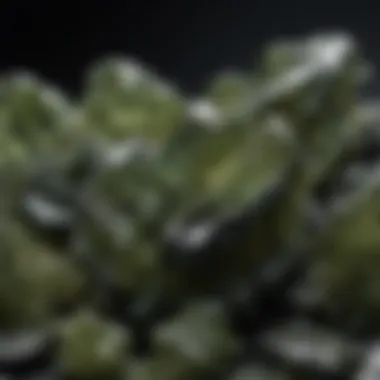

- Use shadow boxes or display cases with interior lighting to highlight the colors and texture of the moldavite.
- Create themed displays that narrate the journey from origin to collection.
Geological Insights
Geological Formations and Processes
Analyzing the geological principles that lead to moldavite formation can enrich an appreciation for this stone. Moldavite is formed from terrestrial substances that undergo tremendous pressure and heat from cosmic impacts. This unique background ties it not only to glass formation but to specific geographical contours.
Historical Significance of Moldavite
Historically, moldavite has garnered both folklore and scientific interest. Legends extend back to Neolithic cultures, believed among ancient peoples to possess mystical properties.
Notable Discoveries in the Field
A variety of findings over the years, marked by careful excavation, validate the history and interest in moldavite. Diversifying acquisitions from the prime sites around the Moldau River can reveal stories attached to both its geological and human narratives.
Preamble to Moldavite
Moldavite occupies a unique position within the world of gemstones, distinctly separating itself from other natural occurrences. Its rarity and beauty have attracted numerous collectors and enthusiasts. Understanding Moldavite is not only a fascinating journey through geology but also an exploration into the intricate connections between nature and human perception. The significance of this section lies in elucidating key aspects of Moldavite including its definition, origin, and the geological imprint it leaves within our planet's history. Collectors particularly benefit from comprehending these foundational elements, as they ensure an informed perspective when acquiring or discussing this remarkable tektite.
Definition and Origin
Moldavite is a type of tektite, a glassy substance formed from the fusion of terrestrial materials during meteoritic impact. Specifically, it is believed to have originated around 15 million years ago during a meteorite impact in what is now the Czech Republic. This extraordinary celestial event allowed minerals from both the impactor and the surface to meld, leading to the creation of Moldavite.
The name 'Moldavite' comes from the Moldau River, which flows in the vicinity of the site where these coveted stones are found. The fascinating backdrop of its formation, blending geographic and cosmic factors, contributes to greatly appreciating Moldavite as a natural wonder.
Geological Significance
From a geological standpoint, Moldavite is significant due to its rarity and the specific conditions that foster its creation. Not many locations on Earth exhibit the perfect blend of factors—chemistry, temperature, and atmospheric conditions—that are necessary for crafting tektites. The unique composition of Moldavite often makes it a keystone for understanding the geological processes linked with meteorite impacts.
Its green color and glassy nature helped in studying the planet's ancient history and meteor impacts. Moreover, Moldavite acts as a geological sample that reflects a brief moment in Earth's timeline, aiding scientists in piecing together the story of our planet, pore by pore.
Physical Appearance of Real Moldavite
The physical appearance of real moldavite plays a crucial role in identifying its authenticity. Recognizing distinct features not only helps in verifying legitimacy but also enhances the appreciation for this unique tektite. Valuable insights into its appearance, such as color spectrum and texture, establish a broader understanding that significantly enriches the collector’s experience. Travelers in the world of toggle can successfully identify genuine pieces and make informed purchases, safeguarding their investments.
Color Spectrum
Moldavite displays a beautiful and varied color spectrum that sets it apart from other minerals. Its colors range from deep green to olive and even dark green, showcasing a unique hue that catches light effectively. The variations arise from iron content in the moldavite or the conditions under which it formed.
- Deep Green: The most common color, often sought by collectors due to its vividness.
- Olive Green: Less frequent, this shade embodies subtler beauty.
- Brownish and Black Shades: Indicating high mineral diversity, these pieces, though rare, intrigue collectors for their geological storytelling.
In addition to solid colors, some pieces may possess an almost transparent aspect called
Common Characteristics of Authentic Moldavite
Understanding the common characteristics of authentic moldavite is essential for collectors and enthusiasts. Identifying these unique traits helps ensure the authenticity of this remarkable tektite, thus safeguarding your investment and interest in this one-of-a-kind gemstone. Authentic moldavite embodies particular physical attributes that are crucial for legitimate identification.
Bubbles and Inclusions
Genuine moldavite often contains bubbles and various inclusions, which play a significant role in its identification. Moldavite formed from the impact of a meteorite with the Earth, its molten lava state allowed for gas bubbles to be trapped in the glass-like substance during cooling. These bubbles varies in size and mainstream presence add a distinct feel to the stone. These characteristics make the stone more than just beautiful; they are part of its story.
When examining moldavite, keep an eye out for the texture that can include this bubble formation. Not all inclusions are created equal. Authentic examples may show signs of naturality, unblemished by aggressive manufacturing processes.
Each piece varies due to the complexity of the creation process. Collectors find beauty in these visuals. Those who appreciate moldavite value its authenticity not only from a cosmetic standpoint but also its pairings to its surface formation.
Shape Variability
The variability of moldavite shapes is another critical characteristic for authentic identification. Natural moldavite presents in an array of forms, including rough, irregular shapes and well-defined contours. The absence of uniformity suggests that the piece has not been sculpted massively. One way to detect genuine pieces from imitations is to assess their contours.
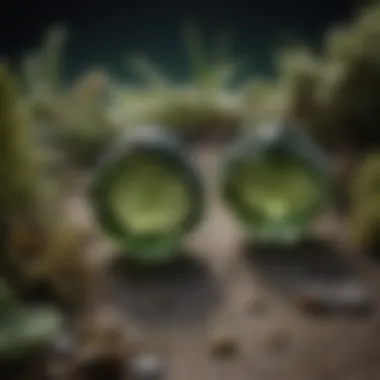

Many fakes tend to have a predictability in shape and can often appear too perfect. This is a common red flag for collectors. Each authentic moldavite piece tells a different narrative through its form, often selected each specific piece due to stocks of color and structure.
There is an illusory sense to this gem that would be simply missing in perfect designs. Slight imperfections in shape contribute significantly. These unique shapes and sizes, while eye-catching, reinforce the natural qualities of moldavite.
In summary, the bubbles and inclusions found in authentic moldavite and unique shape variability holds valuable identifying clues for collectors. The characteristics help protect your collection and add real intrinsic value to the remarkable heritage of moldavite.
Geographical Sources of Moldavite
The geographical sources of moldavite are crucial for understanding its characteristics and significance. Moldavite primarily originates from a single event, known as the impact event, which occurred roughly 15 million years ago when a meteorite struck what is now the Nördlinger Ries in Germany. The unique blend of terrestrial and extraterrestrial materials produced by this event gives moldavite its distinct properties.
Moldavite is mainly found in the regions of the Czech Republic near the Vltava River. Here, two crucial qualities emerge: the purity of the material and access to historical contexts in rock formation studies. This unique geographical distinction separates genuine moldavite from Asheville glass or synthetic crystal products being sold elsewhere.
Primary Locations
The Czech Republic is synonymous with authentic moldavite. Specifically, areas surrounding the Vltava River, especially near the towns of Český Krumlov and Budweis, are renowned for fertile deposits of moldavite. Other spots have been recognized where formations have undergone sedimentary processes. In some cases, clandestine discoveries by enthusiasts have led to new uncharted areas yielding small quantities of this stone.
Despite its identified sources, the relatively limited geographical distribution means collectors must verify the provenance of purchased pieces constantly. Knowledgeable buyers will always seek documentation or a background story that assures the moldavite has a legitimate Czech origin.
Impact of Source on Appearance
The origin indeed plays vital role in the distinct appearance of moldavite. Variations result from changes in geological conditions—temperature, pressure, and chemical composition during its formation. Moldavite minerals often display a glass-like surface that reflects the exact conditions of the region and its elemental history.
Key effects include:
- Color Variation: Depending on the region within the Czech Republic, moldavite can vary is shades from a grass green to an olive and even a dark green hue.
- Translucency: The formation during its creation impacts whether certain pieces are clear or opaque. Rare high-quality samples can be more expensive but are respected for their clarity.
- Inclusions: Minerals embedded within the moldavite, acquiring uniqueness and a reflection of its geological origin. Organic materials could even mix during the moldavite development that contributes to its allure and charm for hobbyists.
Understanding the geographical sources not only elevates collectors' understanding of moldavite but also serves as an educational insight into its unique nature. Collectors are never just assessing crystal forms but the entire narrative of Earth's history locked within each piece.
Distinguishing Features of Fake Moldavite
Recognizing the mga distinguishing features of fake moldavite is essential for anyone serious about cultivating a genuine collection. The market today is rife with imitations that can easily deceive newcomers. One must comprehend the various factors that differentiate authentic moldavite from its counterpart. A clear understanding can serve not only to protect your collection but also to maintain the credibility of the moldavite trade.
Common Imitation Materials
Various imitation materials attempt to replicate moldavite, but their distinct characteristics can highlight their forgery. Some common materials include:
- Glass: Many counterfeit pieces are made from colored glass, which can often mirror the green hue of real moldavite. Unlike real moldavite, glass does not possess any bubbles or unique inclusions typical of natural formations.
- Resin: Synthetic resins are often employed to create fake moldavite. They lack the natural textures and specific discerning attributes found in genuine pieces. The surface of resin imitates is often too smooth, and lacks genuine imperfection.
- Synthetic Tektites: Some counterfeits are crafted from synthetic materials marketed as cosmic or natural in origin. Understanding their origin is essential as authentic moldavite has a very specific geography and history which synthetic versions cannot replicate.
It's crucial to grasp these materials to avoid falling prey to imitations in auctions or market sales.
Manufacturing Techniques of Imitations
In addition to the materials employed, the way fake moldavite is created reveals a lot about its authenticity. Common manufacturing techniques include:
- Blowing and Molding Glass: Many fake pieces originate from factories specialized in glass arts, where they can be mass-produced. Authentic moldavite, however, forms through specific natural events and cannot be replicated in a controlled environment.
- Casting in Molds: Fake moldavite often appears in similar shapes, due to mass production methods that involve creating sand casts. This method gives a uniform, low-cost alternative that lacks individuality of genuine stones.
- Color Dying Processes: Counterfeiters might employ heated treatments to enhance the color of their models, darkening them to imitate lush green colors associated with real moldavite. Authentic resin pieces, however, develop unique character over time that cannot be artificially generated.
Understanding these methods empowers collectors to examine pieces critically, ensuring each item closely aligns with the expected qualities of authentic moldavite.
Testing Methods for Authenticity
Understanding how to verify the authenticity of moldavite is core to its appreciation and investment. Different methods exist, catering to various levels of expertise within the community. Testing not only helps in identifying genuine pieces but also safeguards collectors against counterfeit products. As a consequence, learning about these methods becomes crucial for anyone engaged with moldavite.
Visual Inspection
Visual inspection is often the first line of defense when determining the authenticity of moldavite. It involves a close look at the gemstone’s key features. Genuine moldavite has certain characteristics that are distinct. Here are specific indicators to assess:
- Color Variations: Authentic moldavite displays a unique olive green color. It can show various shades, but an overly uniform green hue could be a sign of imitation.
- Bubbles and Inclusions: Real moldavite frequently contains small gas bubbles and unique inclusions formed during its creation. These imperfections are essential features of genuine pieces.
- Surface Texture: Specialized texture is typical with moldavite. It feels slightly rough or dusty rather than polished and sleek, indicating authenticity.
Despite these cues, it is important to consider lighting conditions and personal judgment when conducting a visual inspection.
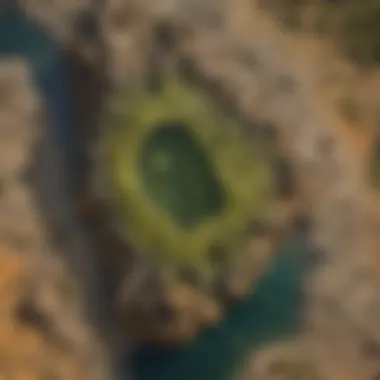

By mastering the visual centers of genuine moldavite, collectors can deepen their connection with each piece they acquire.
Professional Authentication Services
Professional authentication services offer a scientific approach to verifying moldavite. These processes use advanced testing techniques and equipment. Selecting this method provides collectors with stronger assurance regarding the authenticity of their pieces. Common forms of professional services include:
- Gemological Laboratories: Accredited labs can perform detailed analysis on the gemstone using spectroscopy. This technology helps in understanding its composition.
- Certifications: Many professional authentication services provide certificates that vouch for the authenticity and the characteristics of specific pieces.
While the costs may vary, obtaining a certificate may boost a collector's confidence significantly. Always choose a reputable service to ensure both credibility and accuracy. Collecting moldavite is not just about ownership; it’s about having trust in the investment and its genuine nature.
Market Value and Pricing
Understanding the market value and pricing of moldavite is essential for collectors and enthusiasts alike. This area not only influences buying and selling decisions but also reflects broader trends and forces within the rock and mineral market. As a unique tektite, moldavite carries intrinsic value due to its rarity, beauty, and geological significance. Knowledge of its market dynamics can help collectors assess the authenticity and worth of their pieces.
Factors Influencing Price
A variety of elements can impact the price of moldavite. Awareness of these factors equips collectors to make informed investment choices.
- Rarity: Genuine moldavite is rare; it originates from a specific impact event about 15 million years ago. Consequently, pieces that are particularly scarce or unique can command higher prices.
- Quality: The characteristics of the moldavite—color, clarity, shape, and texture—significantly affect its market value. Striking green hues or clear inclusions usually lead to higher prices.
- Size: Larger specimens tend to have a premium, as their sheer volume makes them comparatively rare. A small piece may sell for a lower price point than a substantial specimen.
- Market Demand: Current trends in the gem and mineral market can substantially influence pricing. High demand during certain periods can inflate values.
- Provenance: Pieces with a documented history, such as notable collectors or unique sourcing anecdotes, may fetch higher prices in the market.
These points provide a framework to help determine the potential market value of moldavite.
Current Market Trends
The moldavite market is subject to fluctuations. Being informed about these trends can add depth to any collection and investment strategy.
Currently, there is an increased interest in natural gemstones and minerals. Social media platforms and online marketplaces have accelerated interest and accessibility. This upward trend is driving both demand and prices. Collectors that stay updated about developments in other related markets witness a cross-referral effect, where increased interest in similar species can enhance demand for moldavite.
It's remarkable to note that the emergence of specialized online forums, such as on Reddit or Facebook, provides a community for sharing insights, trading, and discussing market forecasts. Furthermore, it's vital for buyers to keep abreast of ethical sourcing discussions that may evolve into significant influences on pricing.
Moldavite remains an interesting choice for collectors. Its multifaceted value and rich history assure that it remains a noteworthy addition to both casual and serious collections.
Caring for Your Moldavite Collection
Caring for your moldavite collection is essential for maintaining its beauty and value. Real moldavite, known for its unique characteristics, requires specific handling to preserve its integrity. Proper care not only protects your pieces from physical damage but also honors their historical and geological significance. Understanding how to clean, maintain, and store your moldavite ensures that your investment remains in excellent condition.
Cleaning and Maintenance
Cleaning moldavite should be done with careful consideration. This crystal is delicate and improper cleaning methods can lead to scratches or loss of luster. It is crucial to choose the right technique to avoid unhapy results.
- Gentle techniques: Use a soft, lint-free cloth to wipe away dust. This avoids scratching the surface and helps maintain clarity.
- Water rinse: If additional cleaning is needed, a gentle rinse under lukewarm water may remove light impurities. Avoid hot water and keep the process swift to prevent temperature shock.
- Avoid harsh chemicals: Do not use chemical cleaners, as they can damage the stone and its surface.
- Weekly maintenance: Regularly inspect your moldavite pieces for any signs of wear or damage. Early detection allows for prompt action, preserving their beauty.
Maintaining moldavite requires more than just physical care. The energetic properties that many collectors appreciate should also be considered. Mediums suggest that regular cleansing using sound or energy techniques may replenish the crystal's natural vibrancy.
Proper care can greatly enhance the longevity and appearance of your treasured moldavite pieces.
Storage Recommendations
Storing moldavite correctly is just as important as cleaning it. The wrong storage environment can lead to scratches, chips, or other forms of damage. Here are some best practices:
- Use soft cloth pouches: Store each piece individually in cloth bags. This prevents contact with other stones and reduces the risk of scratches.
- Avoid sunlight exposure: Prolonged exposure to direct sunlight might affect the color. Store Them in a dark, dry place.
- Maintain stable temperature: Keep your moldavite in an area with a consistent temperature to avoid thermal stress.
- Secure display case: If you opt to display your collection, use display cases with soft linings and protection to minimize dust exposure.
- Away from chemicals: Ensure the storage area is free from potentially damaging substances, as these might seep, affect the moldavite
In summary, properly caring for your moldavite collection involves both cleaning and careful storage. By following these guidelines, collectors can enhance the longevity and allure of their prized specimens.
End
The conclusion provides an essential synthesis of all the topics discussed. Understanding real moldavite is important for collectors and enthusiasts, not only for appreciation but also for investment purposes. In this guide, we reviewed various aspects, from the origin and physical characteristics to the methods for recognizing authentic pieces versus fakes.
Recap of Key Attributes
Real moldavite possesses specific key attributes that differentiate it from imitations. First, know the unique color spectrum, generally displaying a deep green appearance with some being more olive in hue. Authentic moldavite is also characterized by its distinctive texture and surface characteristics. Often having a glassy feel, its dimensions can vary due to its natural formation. The inclusion of bubbles and variability in shape further emphasizes its genuine nature.
Understanding these traits allows collectors to make informed choices. Both the market value and care of moldavite should be based on these authenticating features.
Final Thoughts on Moldavite Collection
For collectors, engaging with moldavite offers both risk and reward. In the current market, factors influencing price can fluctuate, largely dependent on authenticity and rarity. Caring for your moldavite, through proper cleaning and maintenance, contributes to preserving its value. Thus, one must ensure to store it correctly to avoid damage. Your collection should not only be a display of beauty but also serve as a well-curated investment. Embracing these best practices, you invest in both passion and scholarship in this unique field.
